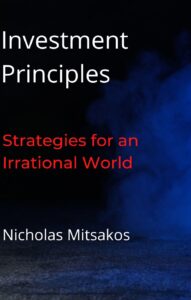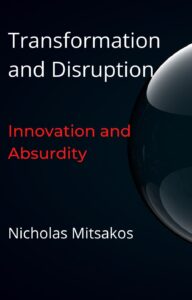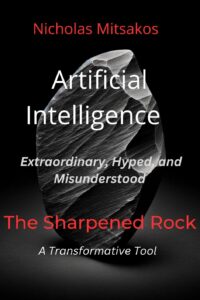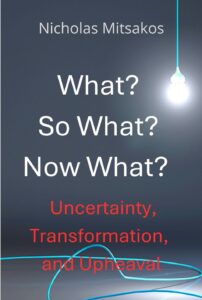- Investment Principles
- Transformation and Disruption
- The Ten Year Horizon
- Cryptocurrency and Digital Assets
- The Sharpened Rock (12.973 × 9.25 in) – 1
- What So What Now What (12.973 × 9.25 in) – 1
Chairman and CEO Nicholas Mitsakos has published six books: “Investment Principles: Strategies for an Irrational World,” “Transformation and Investing: Disruption, Opportunity, and Absurdity,” “The Ten Year Horizon: Volatile, Intense, and Harmless,” “
Nicholas Mitsakos Author’s Page
Investment Principles: Strategies for an Irrational World
Transformation and Investing: Disruption, Opportunity, and Absurdity
The Ten Year Horizon: Volatile, Intense, and Mostly Harmless
Cryptocurrency and Digital Assets: Terror and Opportunity
Artificial Intelligence: the Sharpened Rock
What? So What? Now What? Uncertainty, Transformation, and Upheaval
These books present a broader, more methodical, and more disciplined way to think about investing. Investment success requires understanding many dimensions, including global economics, industry, competitive and microlevel analysis, technological innovation, game theory, and human behavior and emotions. This integrated approach develops a more informed and distinctive way to think about the current investment environment, the future, and what choices to make. Investment success combines predicting the future, the confidence to make bold choices, and the fortitude to stay with those choices.
Nicholas asserts that wisdom, defined as combining a broad range of observations into a new set of knowledge to predict the future more effectively, is essential to successful investing. The foundation of knowledge, assembling relevant facts from many sources, produces better decisions and superior returns. There is no simple formula. Thoughtful observation of complex factors, understanding their interrelation, and predicting the outcome of their interaction is challenging. In Daniel Kahneman’s words, it requires “slow thinking” and demanding work. Breathless and urgent recommendations from social media quips are usually misguided. Superficial ideas and quick thinking are even worse. These books do not contain a series of numerical models and algorithms.
Those kinds of tools are a simplified sideshow intended to turn numerous dynamic factors into a simple, typically misleading analysis. One obvious example is the current investment principle that revenue growth is the only factor that matters in determining a company’s future value. Along with other simplistic approaches, this is often nonsense. The books discuss topics ranging from disruptive innovation and technologies, globalization, leadership, fiscal and monetary policy, and other topics usually relegated to economics or behavioral textbooks. But inferior performance comes from not understanding all the elements, both macro and micro, that influence investment choice, the policies impacting those decisions, the competitive environment, and the leadership qualities essential to succeed within this context.
General statements are a waste of time, profoundly inefficient and misleading, and designed to make the reader feel good without giving him or her any useful way to think more deeply about analysis and more accurate and impactful conclusions. These are not “how to pick stocks” books. Along with platitudes, there are no simple formulae, heuristics, or any other effortless way to outperform the market. Deep thinking about the factors that matter is complex, challenging, unique to each situation, and escapes simplicity.
The books are not organized as straightforward narratives, but each contains sections addressing different, sometimes unrelated, important topics. The foundation comes from Nicholas’s articles and lectures (posted elsewhere on this website under “Writing and Podcasts” and Arcadia’s “YouTube” channel) and may seem disjointed, but each topic and subtopic is meant to stand on its own. The books can be just as effectively read in discrete sections and not necessarily in any narrative series. These can be reference books, as well as a descriptive analysis.
Investment Principles: Strategies for an Irrational World proposes a context for understanding – a broader, methodical, and disciplined way to think about investing. Investment success requires understanding many elements, from global economics, competitive and microlevel analysis, and game theory to human behavior and emotions. This integrated approach develops a more informed and distinctive way to think about the future. Investment success combines predicting the future, the confidence to make bold choices, and the fortitude to stay with those choices. I assert that wisdom, which I define as combining a broad range of observations into a new set of knowledge to predict the future more effectively, is essential to successful investing.
The foundation of knowledge, assembling relevant facts from many sources, produces better decisions and superior returns. There is no simple formula. Thoughtful observation of complex factors, understanding their interrelation, and predicting the outcome of their interaction is challenging. In Daniel Kahneman’s words, it requires “slow thinking” and demanding work. Breathless and urgent recommendations from social media quips are usually misguided. Superficial ideas and quick thinking are even worse. This book does not contain a series of numerical models and algorithms. Those kinds of tools are a simplified sideshow intended to turn numerous and dynamic factors into a simple and, typically, misleading analysis. This approach is nonsense.
This book discusses topics ranging from disruptive innovation and technologies, globalization, leadership, fiscal and monetary policy, and other topics usually relegated to economics or behavioral textbooks. However, inferior performance comes from not understanding all the macro and micro elements that influence investment choice, the policies impacting those decisions, the competitive environment, and the leadership qualities essential to succeed within this context. General statements are a waste of time, profoundly inefficient and misleading, and designed simply to make the reader feel good without giving him or her any useful way to think more deeply about analysis and conclusions that matter. This is not a “how to pick stocks” book. Along with platitudes, there are no simple formulae, heuristics, or any other effortless way to outperform the market. Deep thinking about the factors that matter is complex, challenging, unique to each situation, and escapes simple formulae.
This book is not organized as a straightforward narrative but in sections addressing different topics. The foundation comes from my articles and lectures and may seem disjointed, but each topic and subtopic is meant to stand independently. The book can be just as effectively read in discrete sections and not necessarily in any narrative series. This can be a reference book as well as a descriptive analysis.
Transformational and Disruption: Innovation and Absurdity highlights the extraordinary opportunities and risks associated with disruptive technologies and the global transformation they are causing. Instead of headline-grabbing hyperbole, I attempt to create a context to understand these developments – a broader, methodical, and disciplined way to think about disruption and transformation. Some of the world’s most important industries are being profoundly impacted by new technological innovations and platforms, such as artificial intelligence, digital assets, blockchain-based businesses, gene editing, and DNA sequencing, enabling unprecedented disruption to business and economic models. Investment success requires understanding these impacts and grasping many other economic forces and elements ranging from global economics, game theory, competitive and micro-level analysis, and human behavior and emotions.
Stable predictability is increasingly anachronistic. Every company or industry will either be a disrupter or disrupted. The leading growth companies of today stand an excellent chance to be memories tomorrow. This new world makes stability and a static competitive advantage less relevant. Looking for “moats” is becoming a fool’s errand. Investing will require more technological expertise, knowledge of major developments, and an understanding of the accelerating impact permeating the world’s economy. The factors influencing any investment’s true value are beyond a simple formula. Extraordinary returns are generated by a combination of factors beyond what the market understands. The total of all market decisions does not create an understanding of the future value of any investment. It is a static snapshot, and passive investing works for passive decisions but is a flawed tool for any active decision-maker.
This book discusses topics ranging from disruptive innovation and technologies, globalization, leadership, fiscal and monetary policy, and other topics usually relegated to economics or behavioral textbooks. But, inferior performance comes from not understanding all the macro and micro elements that influence investment choices, the policies impacting those decisions, the competitive environment, and management’s leadership qualities essential to outperform. This book also avoids general statements (“invest in creative destruction,” “disruption and transformation will create wealth”) that sound good and tend to be popular but are meaningless. I am much more concerned with thinking about a problem and developing a unique and better decision.
Specific situations are dynamic and quickly escape a simple formula or any broad sweeping conclusions. General statements are a waste of time, profoundly inefficient and misleading, and designed simply to make the reader feel good without giving him or her any useful way to think more deeply about analysis and conclusions that matter. This is not a “how to pick stocks” book. Along with platitudes, there are no simple formulas or any other effortless way to outperform the market. Deep thinking about the factors that matter is complex, challenging, unique to each situation, and escapes simplicity. This book is not organized as a straightforward narrative but in sections addressing different topics. The contents combine a series of articles and lectures and can seem fragmented. But each topic and subtopic is meant to stand on its own. It can just as effectively be read in different chunks and not in any narrative series. It can be a reference book, as well as a descriptive analysis.
“The Ten Year Horizon”
This book explores the next decade’s more frequent and intense economic, geopolitical, fiscal, and market volatility, technological innovation, disruption, and hype. Long-term opportunity exists, and this book uses a 10-year horizon as a surrogate for a long-term perspective. Some of the world’s most important industries are being disrupted, especially finance via digital assets and Blockchain-based businesses, life sciences via gene editing, DNA sequencing, and CRISPR, and communications via advanced wireless data networks, software technologies including artificial intelligence, and new interactive platforms such as the Metaverse.
Success requires understanding how to assess these industries, the potential disruptions, the sustainability of new business models, and other economic forces and understanding that human emotions swing market cycles, impact values, and skew competitive dynamics. This is not a hyperbolic “this time it’s different” sermon. Still, we are entering an era that will be characterized by persistent uncertainty and rejection of the halcyon days of “growth equals value regardless of profitability.” Vulnerability to economic and social shocks will also be higher, and there may be many dark days along the way to the horizon. The world is becoming a zero-sum chess game. The players, China and the US hope to either control or influence other pieces – queens to pawns – ranging from Russia and Ukraine to India and Turkey. This book explores the chills of discontent that ignited these fractures and looks at potential avenues for re-engagement and mutual benefit.
The foreseeable future is disjointed and fractured, but there may be an ultimate realization that long-term benefit from reigniting mutual engagement will be in everyone’s best interest. Traditional industries that drive the world economy – metals, minerals, plastics, and energy – are essential to any “green revolution.” Technology, innovation, and disruption need minerals, metals, plastics, and energy to build and deploy their products. Technology and potentially life-saving innovation are useless without these basic industries – now impacted more than ever by geopolitics and global trade. Technology and innovation can solve existential threats from climate change to food scarcity and global pandemics. But, as I discuss, technology is also an uncontrollable monster that can lead the world into a downward spiral of distraction and meaninglessness – and solve nothing.
I explore whether the future needs the Metaverse, cryptocurrencies, or NFTs (it doesn’t), Blockchain technology and other digital assets (it can), or artificial intelligence and machine learning (it does). The Metaverse and cryptocurrency are mostly a sideshow. Blockchain and digital assets are platforms enabling the digitization and potential disruption of finance. While all these technologies are often lumped together, I discuss the significant distinction between them. I also explore what can be predicted, what should be ignored, and why basic science and fundamental discovery are our most potent weapons and greatest opportunity to create value and benefit society. I emphasize the need to ignore policy recommendations that attempt to manage outcomes for a shortsighted, politically popular goal. I close this book with some very personal thoughts from my experiences.
“Cryptocurrency and Digital Assets: Terror and Opportunity”
This book addresses the over-hyped world of cryptocurrency and explores an underlying disruption to global finance. Cryptocurrencies soar in value, plunge, hit new highs, are written off, rebound, and hit new highs again, and the cycle repeats. We should be terrified. Over the last five years, cryptocurrencies such as Bitcoin and Ether have outperformed the overall market. However, can the general trend of outperformance last, or will these digital assets drop over 90% like some of its other crypto brethren? Is there a sustainable performance that creates the foundation for either a new currency or a valuable asset class? Probably not.
Forces that drive these eye-watering returns seem to be the same as those that drove the social media-driven insanity behind meme stocks such as GameStop. We are seeing social media mobs controlling demand to a limited supply, creating price spikes that look attractive to any speculative investor. Unfortunately, demand can dry up quickly, and the price subsequently falls through the floor. The volatility is hard to gauge. It fizzled once and recovered and fizzled again and then somewhat recovered. Is any of this sustainable? It may not matter. There is something more fundamentally valuable happening with digital assets. Distributed ledger technology, or blockchain, radically simplifies financial markets and, more importantly, fundamentally changes market infrastructure.
While this will take time, regulatory requirements, and undoubtedly government cooperation for these changes to materialize truly, digital asset technology enables the decentralization of critical data to entirely new financial systems and capital flows without the need for traditional intermediaries. In other words, the entire global financial infrastructure as we know it today. This is a real disruption and has the potential to create enormous value. In this book, I will explore the role of digital assets, cryptocurrency, distributed ledgers, and the future of capital markets. While crypto may not be a currency, it is an emerging asset class that needs to be understood, its speculative nature unpacked, and its prospects analyzed. It may not be the revolution its creators hope for, and it hardly seems a financial revolution, but it is pervasive enough to warrant analysis and understanding.
Decentralized finance can disrupt global finance but only if private financial systems and central governments cooperate. This seems unlikely – sworn enemies understanding the greater good is rare (mostly in novels). However, a cooperative relationship between decentralized and efficient financial structures and government systems, regulations, and central banks with stable currencies is absolutely necessary. I will explore this idea in detail, including the concept of a digital central bank. While we understand that bureaucratic governments lack initiative, creativity, and foresight, central banks and governments armed with simplicity, clarity, and algorithms may add efficiency, access, and global interconnection, enabling an improvement to the quality of life of most people whether they have bank accounts or not. Financial markets ruthlessly sort nonsense from substance.
Volatility and existential threats have been brutal and extreme for digital assets, and the reckoning for crypto has been predicted for some time. However, digital assets are not on their way to history’s dustbin. Reality is more nuanced, and I try to provide a more detailed analysis since a broad brush hardly seems appropriate. The weakest and craziest portions of the crypto world have been exposed as nothing more than silliness. However, some valuable components remain resilient and offer tremendous opportunity. I will explore these in detail. There is more cause for optimism than pessimism among the best and the brightest. We will explore these opportunities while harshly dismissing the hype and silliness – avoid the terror of worthless market frenzies.
This book underscores the importance of recognizing AI as a powerful tool under human direction, not an autonomous entity with consciousness or emotions. It examines artificial intelligence’s opportunities, limitations, and risks while giving a reality check to the hyperbole and fears. The first and most crucial principle in understanding AI is recognizing its inherent nature as a tool, a creation of human ingenuity designed to augment, rather than replace, human intelligence. AI systems, at their core, are complex algorithms capable of processing and learning from data at a scale and speed unattainable by human cognition. However, it is an unprecedented, powerful tool that can permeate every aspect of society, industry, and human ingenuity globally.
Its impact can be equivalent to Prometheus giving humans the gift of fire. Artificial intelligence is permeating our lives, and much like electricity at the turn of the last century, its dramatic and long-term impacts are only beginning to be understood, and applications using this ubiquitous technology are filled with promise, hyperbole, hope, and optimism – sometimes misplaced and sometimes understated. AI is expansive and exhilarating, potentially leading to more autonomous AI systems and an impactful integration into everyday life. As this book’s title indicates, this tool’s power is equivalent to humankind’s development of the sharpened rock. A transformative and effective tool that enables more efficient applications, creativity, more manageable workloads, and potential risks. After all, a sharpened rock is also a weapon. Artificial general intelligence is not a surrogate for human intelligence and is overstated and misleading. Artificial General Intelligence is excellent at pattern recognition and intense statistical analysis; however, intelligence is not merely about pattern recognition or generating responses based on probabilities.
True intelligence involves creative conjectures, critical thinking, and moral reasoning, areas where AI, including advanced large language models, still falls short. Artificial intelligence faces many challenges, including extracting value from data deluge and AI systems’ probabilistic nature. While indisputably a powerful tool, much like sharpened rock, it is a transformative tool for humankind. It comes with great potential and unpredictable benefits and risks. AI systems lack the capacity for top-down reasoning, making them fundamentally brittle and prone to breakdowns at the edges of their operational parameters. While useful within their comfort zones, these systems struggle with unusual circumstances and edge cases not common in their data sets and training data.
This book aims to present a comprehensive and balanced perspective on AI, acknowledging its transformative power while highlighting the need for a cautious and informed approach to its development and integration. A nuanced understanding is essential, recognizing AI’s potential as a tool for advancement while being mindful of its limitations, ethical implications, and the importance of human oversight in its deployment.
“What? So What? Now What?: Uncertainty, Transformation, and Upheaval”
This book is about uncertainty and decisions. This book helps readers better understand a situation (What), determine why it’s important (So What), and decide what to do next (Now What). The world is uncertain, and all decisions are made in an uncertain environment with unpredictable outcomes. This challenge transcends disciplines, industries, and professions. An increasingly complex modern world shaped by artificial intelligence, geopolitical instability, data overload, and rapidly evolving technology can overwhelm decision-makers who rely on outdated ways of thinking.
Uncertainty is unavoidable. It is not the enemy. It can be navigated with structure and discipline. Critical thinking, multiple perspectives, and decision tools help prioritize, forecast, and adapt decisions, but cannot dictate outcomes. “Decision Intelligence” is vital because it combines data, models, and human judgment, all augmented with new technologies, especially artificial intelligence. Better decisions come from clarity, not certainty. This is the foundation of resilience, agility, and better decision-making during volatile, unpredictable, and transformative environments. Since uncertainty permeates all decisions, acknowledging this and understanding how to manage uncertainty is crucial. Context, influential factors, nontraditional thinking, and problem definition are core to all decision-making in an uncertain environment.
Structured thinking, decision intelligence, and a helpful framework enable a more functional understanding of the context within which a decision will be made, avoid biases and other pitfalls, and result in more effective choices. This book discusses a variety of uncertain circumstances we are all increasingly confronting daily, including healthcare management, weather prediction, capital allocation, critical business decisions, and even self-driving cars – circumstances that require decision-making with imperfect and incomplete information. The book provides a more comprehensive analysis and application of the tools described to address with greater detail and substance the most transformative and uncertain developments today: geopolitical upheaval, the impact of artificial intelligence, and other components of transformation, disruption, and uncertainty that require more critical and thorough thinking. Such impactful disruptions must be approached thoroughly, systematically, and with plausible scenarios.
This book applies context and common sense to structured thinking and planning. I aim for readers to develop a deeper understanding of uncertainty, not just as a theoretical concept, but as a practical challenge in every real-world decision. An appreciation of structured thinking: frameworks like the Decision Canvas, scenario planning, and pre/post-mortem analysis are mental scaffolding that improves clarity and reduces bias. Familiarity with decision-making tools and technologies: reinforcement learning, optimization, probabilistic reasoning, and decision intelligence systems.Awareness of common decision traps, such as cognitive biases, confirmation bias, overconfidence, and sunk cost fallacies, and strategies to overcome them.Strategies for building decision systems: embedding decision quality into your team, culture, and organization’s processes. It’s not simply a matter of having a formula. Uncertain circumstances are not simple mathematical problems but require systematic and structured thinking. Understanding these structures and the motivations behind the various approaches will be essential.
This approach is more of a way to think about thinking. As Einstein said, “Give me 60 minutes to solve a problem, and I will spend 55 minutes defining it. Then the solution will be obvious.”
This book is about those 55 minutes.






